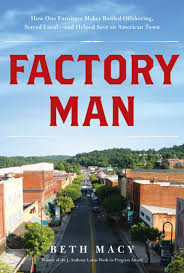‘Merican-Made: Beth Macy’s Factory Man
Several years back after teaching lessons on US labor history I became interested in modern labor practices and how to be a thoughtful consumer. Our family income was improving and while we are far from buying jewelry or vacation homes, there were opportunities here and there to get a piece of furniture or a nice item of clothing. Skipping Craig’s list and looking at new couches in a store was a treat. I started to wonder: Where do the things I buy come from? And how was it made? Are the workers making a decent wages or slaving in a sweat shop? I decided to try to avoid cheap, to purchase less, and when possible, to buy items made in the United States and/or goods that have a greener history.
This has made for some interesting challenges on the shopping front. For instance, if you do not favor the expensive New Balance sneakers made in the USA, choices are slim. I also know that my strategy does not make all that much of a difference, is not sustainable, and probably rests on questionable assumptions. What I do know, though, is that is has made me a more conscious consumer. That, I hope, has been to the good.
I mention all of this to help you understand my thoughts about journalist Beth Macy’s Factory Man: How One Furniture Maker Battled Offshoring, Stayed Local – and Helped Save and American Town. It is a fascinating book, or rather three books, welded together. Well-written, engaging, and popular, Factory Man also highlights that “made in America” is about more than economics. It touches us emotionally, nationally, and ethically.
One focus of Factory Man is the business history Bassett Furniture Industries, a Virginia company founded in the early 1900s by two Bassett brothers. The company took advantage of inexpensive labor from Appalachia, building a factory town and exercising all manner of control as the firm flourished. Bassett furniture appealed to the burgeoning middle class. Since copyrighting furniture styles is well-nigh impossible, a smart designer – and Bassett invested in talent here – can copy and adapt with tremendous success. There was no culture of craftsmanship or innovation at Bassett, save making more money. Bassett’s growth and expansion, up until the threat of globalization, mirrored that of many other domestic industries geared toward the broad consumer market. Control expenses, find new ways to market, and seek profit.
Macy prefers people to business, though, so much of her attention returns to the people involved in Bassett. She spends years tracking down family lore, from sibling rivalries to sexual relationships between management and labor. Families involved in the furniture business inter-marry, form partnerships and break up acrimoniously. It is a bit like medieval history, without the flags. Macy is equally attuned to the history of labor in the factory towns, interviewing workers and their families. Their voices are valuable, but their perspective is limited, just as their straits were curtailed. Working at Bassett provided a wage but not much of a way of life. Those with ambition left the company towns. Much of Factory Man is colored through the lens of an inquisitive outsider trying to make sense of complicated family dynasties and their impact on the local communities.
The final key component of the book is the story of John D. Bassett III, family outsider who returns and leads the political charge against the tide of Chinese furniture imports. Led by Larry Moh, a brilliant business man, Chinese companies began to use very same techniques as Bassett to increase market share. Chinese manufacturers kept labor costs very low, controlled costs of ingredients, and copied designs. American companies responded by directing more manufacturing to Asia and shifting attention to retailing directly. US manufacturing jobs steadily disappeared. The strategy was at best a delaying tactic. Asian manufacturers started selling to other retailers and US furniture companies lost more share of the market. JD Bassett III put a halt to the trend by building a coalition of American furniture manufacturers and pressing an anti-dumping case against Chinese furniture makers. It took years and millions of dollars, but he eventually prevailed. The US case was “won” resulting in penalties and fines that eventually made it back to US companies.
It is, on one level, a great story: a “factory man” successfully fights globalization and keeps a local industry and community alive. Tom Hanks has optioned the book and it is easy to see him in the lead role.
On the other hand, Macy’s book raises more questions than it answers. Who, exactly, has won or lost here? Do workers benefit? It is difficult to argue that Bassett, despite the jobs it provided, values labor any more than its foreign competitors. Regulation and other macro-economic factors account for the differences. The US furniture industry, too, did not seem to do anything creative to either keep jobs in the US or to distinguish itself. The book regularly highlights the lack of investment, research, or innovation in Bassett industries. It is possible, in fact, to argue that the domestic furniture industry got what it deserved.
Factory Man left me a little wiser and more thoughtful. Reaching for the “made in America” label is no guarantee, but it remains a good place to start. And when it comes to furniture, I may be looking for antiques.
David Potash